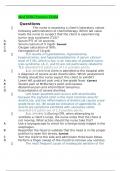NUR 376 Pathophysiology Exam 1 (Chapters 2,
7, 8 (Cell injury and Fluid/electrolytes)/ 90+
Q&A/ 2024-2025.
A biopsy of a skin lesion is conducted on Leann, a 48-year-old woman. Biopsy
results revealed proliferating cells that were well-differentiated and resembled
surrounding cells. The cells were contained within a well-defined area. - Answer:
Benign neoplasia.
Neoplasia is uncontrolled and unregulated cell growth. The mass of tissue
resulting is known as a "neoplasm." In a benign neoplasm, the cells do not have
the characteristics associated with malignancy. The cells, although cancerous, are
well-differentiated, meaning they resemble normal, mature cells. The cells are
also in a contained area and are unlikely to spread.
Page 1 of 25
,Miguel, a retired warehouse supervisor, had a myocardial infarction. Further
evaluation revealed he had significant blockage in his left descending coronary
artery. The blockage resulted in ischemia and cell death for those cells served by
the artery. - Answer: Necrosis
Necrosis is premature cell death caused by cell injury. Necrosis differs from
apoptosis, in that the cellular destruction results from some form of trauma,
rather than genetic programming. May lead to GANGRENE which is when dead
tissue houses bacteria.
Brian, age 28, began an aerobic exercise program 2 years ago. Brian now
competes in long-distance cycling events and considers himself to be an
endurance athlete who is in the "best shape of his life." An echocardiogram
reveals a slightly enlarged left ventricle. What cellular change or injury that is best
exemplified by the case scenario. - Answer: Physiologic hypertrophy
An ADAPTIVE type of hypertrophy that occurs due to extensive exercise, whereby
the heart will create new blood vessel branches (angiogenesis) and there is
increased mitochondria, ATP, and actin/myosin filaments in the muscle.
Recently, Karen learned that not only does HIV directly attack CD4 cells, but the
presence of the virus seems to activate pathways responsible for programmed cell
death in CD4 cells. Thus, HIV infection appears to increase the rate of "suicide" for
CD4 cells. - Answer: Apoptosis
Page 2 of 25
, Define dysplasia - Answer: Compared to normal cells, cells demonstrating
dysplasia are atypical in size and shape. Dysplasia does not mean the cells are
cancerous. However, some screening tests, such as the Pap smear, examine tissues
to determine if any cellular changes are taking place. Any changes in the cells can
then be monitored over time.
Julianne, who suffers from familial hypercholesterolemia, presents with
xanthomas. Xanthomas are excess cholesterol deposits, which appear as yellow
skin lesions. What cell process is this - Answer: Intracellular accumulation.
Some disease processes stimulate intracellular accumulations of particles, such as
calcium, cholesterol, and triglycerides, glucose, among other substances. In
familial hypercholesterolemia, a genetic defect causes decreased cellular uptake
of cholesterol, resulting in high serum cholesterol levels. Cholesterol deposits,
known as xanthomas, may appear to form under the skin.
Janae experienced a frightening ATV accident, in which her ATV flipped over and
she ended up catching a portion of her upper arm on a barbed wire fence.
Although Janae's injuries healed fully, enlarged, keloid scar formations remain at
the injury site. - Answer: Hyperplasia
cell proliferation, known as hyperplasia, was stimulated as a result of her injury. A
keloid results from overgrowth of granulation tissue during the wound repair
process.
Page 3 of 25






